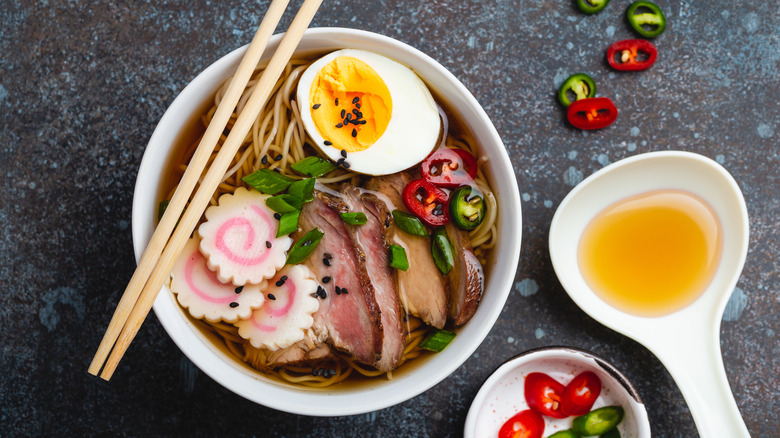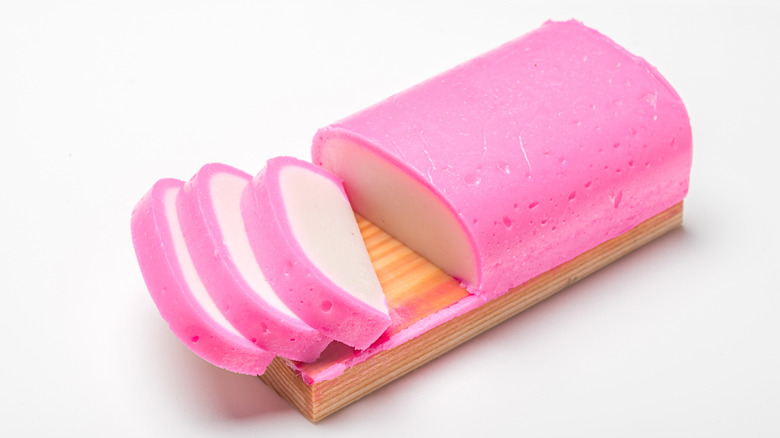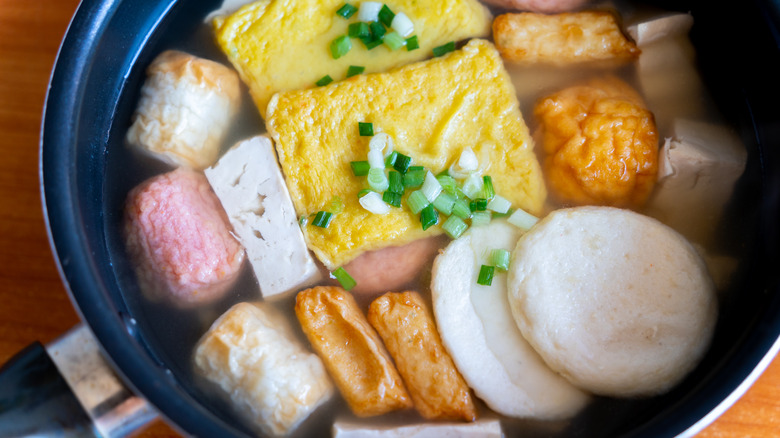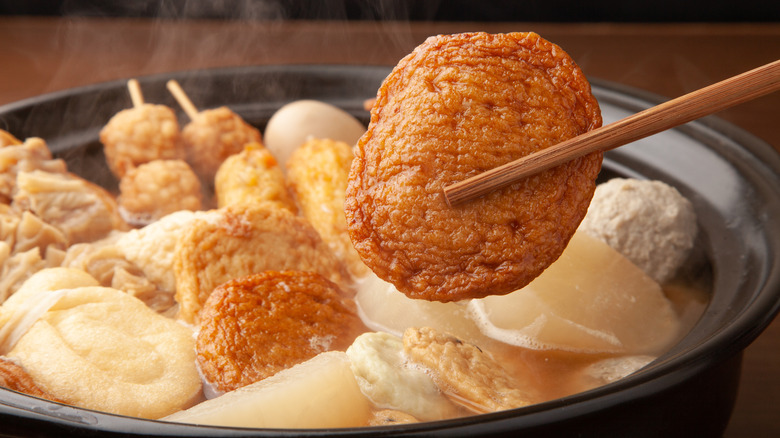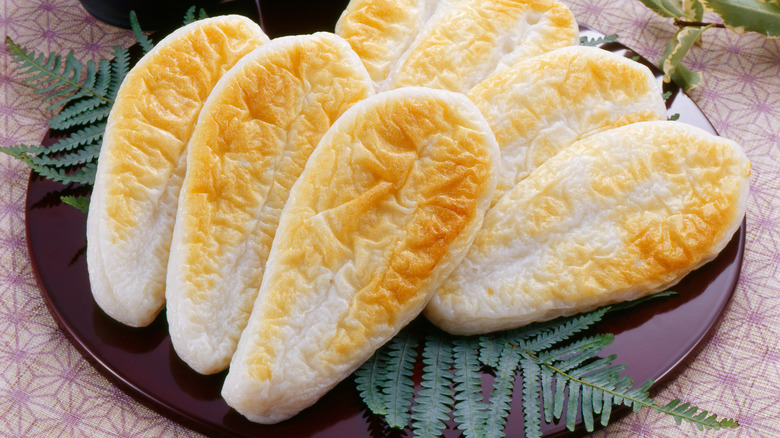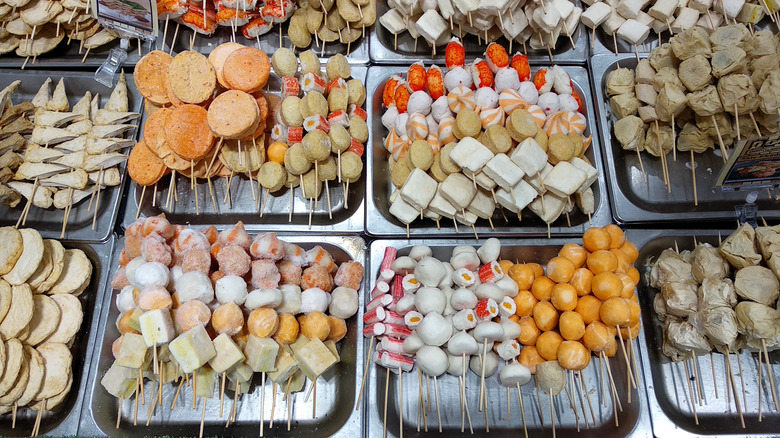What Is Japanese Fish Cake And How Is It Eaten?
We may receive a commission on purchases made from links.
If you've ever ordered ramen from a Japanese restaurant, you've probably seen that white and pink swirled, meticulously sliced disk floating atop your noodles. Maybe you decide to eat it first before you slurp down your bowl, or maybe you're the patient type and save it for the end. You also might hate the chewy delicacy and always offer it to your dining mate.
Whatever the case, there's no denying how iconic this noodle soup topper is (it even has its own emoji). This garnish is a type of Japanese fish cake called narutomaki; fish cakes in Japan fall under an umbrella term called kamaboko. Like many other ancient culinary tricks that started from the need to preserve food, salted fish was formed into a gel or paste to help increase its shelf-life without the need for refrigeration. Kamaboko's origins go all the way back to the eighth century, where it was served on a stick and cooked over a fire at a nobleman's dinner party (via MasterClass). Over the years, kamaboko grew to be so popular and beloved that the Japanese designated November 15 Kamaboko Day in 1983. Kamaboko also has an entire museum dedicated to its rich history.
Narutomaki is probably the most well-known of the fish cake varieties, but there are at least 10 more to learn about, plus a ton of other interesting kamaboko facts. Let's dive in!
What is Japanese fish cake made of exactly?
Kamaboko comes in many different flavors and preparations, each with its own special use in Japanese cooking. On the most basic level, a Japanese fish cake is formed by combining different types of white fish into a paste called surimi, which means "minced meat" in Japanese (via MasterClass). Surimi was traditionally made in Japan made by salting fish and grinding it into a paste or gel. In the 1960s however, a Japanese chef figured out that adding sugar to the minced fish gives it a much longer shelf life, and so a booming surimi industry was born (via Thrillist).
The most popular surimi is imitation crab meat, which most of us have probably enjoyed in Americanized California sushi rolls. Surimi is usually formed from pollock or other white fish, according to Reader's Digest. The fish is washed, finely minced, mixed with a binder and other additives, formed into a loaf, and steamed until firm. Rinsing the fish first removes soluble proteins, making the fish chewier (via MasterClass).
Japanese fish cake varieties and how they're made
According to MasterClass, there are 11 main types of kamaboko. Generally, we can divide kamaboko into two types: steamed and grilled or fried.
Narutomaki is in the steamed camp, with a visually striking pink swirl design. To make the swirl, half a sheet of surimi is dyed red and rolled into a log, then steamed and cut. Red and white kamaboko are two more common types of steamed log surimi and are usually eaten during the Japanese New Year, as red and white are considered good luck colors. White kamaboko is steamed and then sometimes grilled until it turns golden.
Kani kamaboko, the Japanese version of imitation crab, is made by seasoning surimi with crab liquid. Then we have chīkama, or "fish meat and cheese sticks." Chīkama is basically surimi fish paste mixed with cheese (which, by the way, is not a popular concept) and ends up looking sort of like string cheese. Last in the steamed category is specialty kamaboko, where the inside of the cake is decorated with colorful designs.
Chikuwa, jakoten, sasa, satsuma, and hanpen are all fish cakes that are shaped then grilled, or fried in batter. Sometimes the surimi is mixed with flour or yams before cooking, too (via MasterClass).
How do you eat it and what does it taste like?
Now comes the fun part: eating. For the steamed cakes, most are used as toppers and garnishes for soups like ramen, soba, and udon. Sometimes you see narutomaki in sushi, too. Specialty kamaboko is usually found in bento boxes (via MasterClass) and served during the New Year. As far as taste goes, descriptions on Reddit range from "negligible" to "I love the stuff." Redditors point out that the taste often comes second to the visual appeal of the cake.
According to The Spruce Eats, most of the fried and grilled kamaboko are served on their own or eaten as snacks dipped in ginger and soy sauce or mustard. Sasa kamaboko, for example, is a grilled fish cake from the Miyagi prefecture that's shaped to look like a bamboo leaf. Once grilled, the cake is plump and fluffy with a slight spring and a mildly sweet, roasted fish flavor. Satsuma-age, a deep-fried fish cake, even has its own subcategories depending on what shape it's formed into before cooking. Chikuwa is a grilled, toasty-tasting fish cake shaped into a long, hollow tube that's typically added to Japanese stew or fried in a crispy tempura batter.
Is Japanese fish cake healthy?
When you think of anything fish-related, you can pretty much bet it's going to be somewhat healthy. And that's the case for Japanese fish cakes. High-quality kamaboko, according to Umami Insider, contains plenty of protein and can be relatively low fat. One 3-ounce serving of narutomaki has just 70 calories and over 10 grams of protein (via FitDay). Considering that an average 150-pound woman needs around 53 grams of protein per day (per VerywellFit), popping a couple of fish cakes into your rotation will get you almost halfway there.
The thing that you have to watch out for with kamaboko is sodium. Just one 3 ounce serving of narutomaki contains 719 milligrams of sodium (via Carb Manager), but since it's high in protein and low in fat, "healthy" just depends on what you need and portion control. Generally, though, Japanese fish cakes are relatively good for you, especially the steamed variety.
Where to buy Japanese fish cakes
Depending on where you live and whether or not you have easy access to an Asian supermarket, Japanese fish cake varieties can be readily available. Steamed varieties are often found in the refrigerated or frozen section of the market, and fried ones are usually available frozen (via Just Bento). At the large Asian chain market 99 Ranch, for example, you'll find frozen logs of narutomaki. H Mart, another popular grocery, sells a variety of fish cakes too.
If you aren't lucky enough to live anywhere near an Asian market, have no fear, Amazon to the rescue! Yamasa, the first U.S. manufacturer of imitation crab, sells red kamaboko through Amazon. And if you're willing to pay for shipping, several types of fish cake varieties can be shipped to you frozen through the London-based mega shop Japan Centre, although they've recently paused international shipping. Of course, if you're feeling especially motivated and want to impress your friends with a cozy bowl of authentic ramen, you can also try making your own fish cakes at home.
